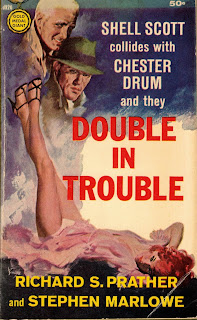DOUBLE IN TROUBLE
By Richard S.
Prather & Stephen Marlowe
Gold Medal Giant
Copyrighted 1959
Fawcett Publications, Inc.
Second Printing 1960
286 pages
In 1960, we were a thirteen-year-old freshman in high
school. We are also a veracious reader, having been weened on comic books at an
early age. We loved reading and by that year were devouring every kind of
paperback book we could get our hands on, from the Ace versions of Edgar Rice
Burroughs fantasy adventures to the hard-boiled private eye series that seem to
proliferate the drug store spinner racks. In that genre, abided some rather
heady material for a shy, nerdy teen. Covers sporting sexy femme fatales in
skimpy attire alongside tough-guy shamus were the norm and through them we
entered the seedy world of such colorful heroes as, Mike Shane, Johnny Liddell,
Mike Hammer, Rocky Steele, Stuart Bailey and Nick Carter to name few. Our
personal favorite was Shell Scott. With his white hair and wise-cracking wit,
Scott operated out of sunny Los Angeles, California; a far cry from the mean
streets of the East Coast metropolises.
Scott was created by writer Richard Scott Prather (Sept. 9,
1921 – Feb. 14, 2007). His cases were Prather’s most successful series. He also
wrote under the pen-names David Knight and Douglas Ring. The first Shell Scott mystery,
Case of the Vanishing Beauty, was published in 1950. There would be more
than three dozen to follow. Before his death, Prather donated his papers to the
Richard S. Prather Collection at the University of Wyoming, in Laramie,
Wyoming. The only thing we remember
about those .25 cent paperbacks was Scott’s wry humor and weakness for
beautiful dames.
Another private eye series from Fawcett at that time were
the Chester Drum books by Stephen Marlowe. Drum operated out of Washington,
D.C. and was a no-nonsense guy always ready with both his fists and his .45 Magnum.
Marlowe was Milton Lesser, (Aug. 7, 1928) born in Brooklyn, New York and died
(Feb 22, 2008) in Williamsburg, Virginia. Unlike Prather, his own work covered
a wider field including science fiction and fictional autobiographies of Goya,
Columbus, Miguel de Cervantes and Edgar Allan Poe. He also wrote under various pseudonyms and was
awarded Life Achievement Award by the Private Eye Writers of American in 1997.
His first Chester Drum mystery appeared in his 1955 novel, The Second
Longest Night.
Now imagine our surprise when we were looking at the latest
paperback releases on the rack when we came across a thick book with both Shell
Scott and Chester Drum on the cover. Both writers’ credits appeared under the
saucy looking redheaded painted there. We couldn’t believe it. Someone had come
up with the idea of teaming these two highly popular characters in one book
aptly titled, Double in Trouble. Naturally we plunked our .50 cents on
the counter and rushed home eager to read it. That was sixty-five years ago.
Whether we liked it or not back then, is a lost memory in time. What was cemented
into our still developing brain was the uniqueness of pairing two characters from
two successful series. At 13, it was
like Thor fighting the Hulk. Over the years we lost our copy and had forgotten
the book until, while online, some twenty years ago, we got into a discussion
with other private eye enthusiasts and the title was mentioned. We chimed in
with our recollection and bemoaned the fact that no other publisher had ever
thought to reprint such a ground-breaking book. Several weeks later, we received
a dog-eared copy of Double in Trouble in the mail. It was a gift from
fellow writer, Mark Ellis. We were extremely grateful, put it up on a bookshelf
and vowed not to lose that one. Four
days ago, at long last, we picked it up and read it again. Honestly, it was
pretty much like a first time, as we truly had no actual memories of that first
experience.
So now, the review. One would imagine writing a book where the
two stars would narrate their adventures in first person would be tricky to say
the least. How Prather and Marlowe managed it, we can only guess. Each chapter
is by either Scott in L.A. or Drum in
D.C. Both, through different circumstances, get involved via a mysterious and
beautiful woman. They are drawn mystery that revolves around a Senate
Sub-Committee investigating criminal activities in a nationwide trucker’s union.
As is typical, within the early
chapters, both are threatened by either gunfire or badly knocked around by Neanderthal-like
goons. At some point in the back-and-forth
orations, Scott learns of Drum and vice-versa. Then when the two connect on a
long-distance phone call, rather than explain their participation in the case,
each fumbles his words so as to give the other the impression they are part of
the nefarious activities the other is looking into.
Now this misstep continues all the way to the book’s last act
in which they come face to face on a stormy night out in an abandoned Virginia country
airport. At which point, they attack each other, and Prather and Marlowe
proceed to give us one of the most brutal, detailed and savagely funny fistfights
ever put on paper. It alone is worth the price of admission. Thus resulting in
both finally awakening to the fact they are actually on the same side and have
to team-up to beat the bad guys once and for all. The conclusion is brilliant and,
in the end, delivers what the entire premise promised. As for this reviewer, it
is now obvious we were much too young to appreciate Double in Trouble when
it was first released. Today, we soundly applaud two skilled pulp scribes;
masters of their genre and thank them for what is truly a wonderful treasure
from the past. Now somebody please reprint the darn thing!


